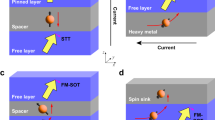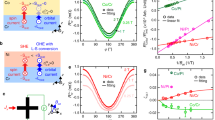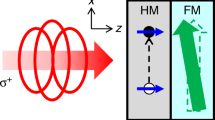Abstract
Spin transfer torques allow the electrical manipulation of magnetization at room temperature, which is desirable in spintronic devices such as spin transfer torque memories. When combined with spin–orbit coupling, they give rise to spin–orbit torques, which are a more powerful tool for controlling magnetization and can enrich device functionalities. The engineering of spin–orbit torques, based mostly on the spin Hall effect, is being intensely pursued. Here, we report that the oxidation of spin–orbit-torque devices triggers a new mechanism of spin–orbit torque, which is about two times stronger than that based on the spin Hall effect. We thus introduce a way to engineer spin–orbit torques via oxygen manipulation. Combined with electrical gating of the oxygen level, our findings may also pave the way towards reconfigurable logic devices.
This is a preview of subscription content, access via your institution
Access options
Subscribe to this journal
Receive 12 print issues and online access
$259.00 per year
only $21.58 per issue
Buy this article
- Purchase on Springer Link
- Instant access to full article PDF
Prices may be subject to local taxes which are calculated during checkout





Similar content being viewed by others
References
Wolf, S. A. et al. Spintronics: a spin-based electronics vision for the future. Science 294, 1488–1495 (2001).
Brataas, A., Kent, A. D. & Ohno, H. Current-induced torques in magnetic materials. Nature Mater. 11, 372–381 (2012).
Zutic, I., Fabian, J. & Das Sarma, S. Spintronics: fundamentals and applications. Rev. Mod. Phys. 76, 323–410 (2004).
Awschalom, D. D. & Flatte, M. E. Challenges for semiconductor spintronics. Nature Phys. 3, 153–159 (2007).
Katine, J. A., Albert, F. J., Buhrman, R. A., Myers, E. B. & Ralph, D. C. Current-driven magnetization reversal and spin-wave excitations in Co/Cu/Co pillars. Phys. Rev. Lett. 84, 3149 (2000).
Ralph, D. C. & Stiles, M. D. Spin transfer torques. J. Magn. Magn. Mater. 320, 1190–1216 (2008).
Miron, I. M. et al. Perpendicular switching of a single ferromagnetic layer induced by in-plane current injection. Nature 476, 189–193 (2011).
Liu, L. Q. et al. Spin–torque switching with the giant spin Hall effect of tantalum. Science 336, 555–558 (2012).
Miron, I. M. et al. Fast current-induced domain-wall motion controlled by the Rashba effect. Nature Mater. 10, 419–423 (2011).
Miron, I. M. et al. Current-driven spin torque induced by the Rashba effect in a ferromagnetic metal layer. Nature Mater. 9, 230–234 (2010).
Liu, L. Q., Pai, C. F., Ralph, D. C. & Buhrman, R. A. Magnetic oscillations driven by the spin Hall effect in 3-terminal magnetic tunnel junction devices. Phys. Rev. Lett. 109, 186602 (2012).
Demidov, V. E. et al. Magnetic nano-oscillator driven by pure spin current. Nature Mater. 11, 1028–1031 (2012).
Jamali, M. et al. Spin–orbit torques in Co/Pd multilayer nanowires. Phys. Rev. Lett. 111, 246602 (2013).
Suzuki, T. et al. Current-induced effective field in perpendicularly magnetized Ta/CoFeB/MgO wire. Appl. Phys. Lett. 98, 142505 (2011).
Ryu, K-S., Thomas, L., Yang, S-H. & Parkin, S. Chiral spin torque at magnetic domain walls. Nature Nanotech. 8, 527–533 (2013).
Emori, S., Bauer, U., Ahn, S. M., Martinez, E. & Beach, G. S. Current-driven dynamics of chiral ferromagnetic domain walls. Nature Mater. 12, 611–616 (2013).
Lee, K-S., Lee, S-W., Min, B-C. & Lee, K-J. Threshold current for switching of a perpendicular magnetic layer induced by spin Hall effect. Appl. Phys. Lett. 102, 112410 (2013).
Fan, X. et al. Observation of the nonlocal spin–orbital effective field. Nature Commun. 4, 1799 (2013).
Pai, C-F. et al. Spin transfer torque devices utilizing the giant spin Hall effect of tungsten. Appl. Phys. Lett. 101, 122404 (2012).
Haazen, P. P. J. et al. Domain wall depinning governed by the spin Hall effect. Nature Mater. 12, 299–303 (2013).
Kim, J. et al. Layer thickness dependence of the current-induced effective field vector in Ta|CoFeB|MgO. Nature Mater. 12, 240–245 (2013).
Fan, X. et al. Quantifying interface and bulk contributions to spin–orbit torque in magnetic bilayers. Nature Commun. 5, 3042 (2014).
Liu, L. Q., Lee, O. J., Gudmundsen, T. J., Ralph, D. C. & Buhrman, R. A. Current-induced switching of perpendicularly magnetized magnetic layers using spin torque from the spin Hall effect. Phys. Rev. Lett. 109, 096602 (2012).
Pi, U. H. et al. Tilting of the spin orientation induced by Rashba effect in ferromagnetic metal layer. Appl. Phys. Lett. 97, 162507 (2010).
Garello, K. et al. Symmetry and magnitude of spin–orbit torques in ferromagnetic heterostructures. Nature Nanotech. 8, 587–591 (2013).
Qiu, X. et al. Angular and temperature dependence of current induced spin–orbit effective fields in Ta/CoFeB/MgO nanowires. Sci. Rep. 4, 4491 (2014).
Chen, C. T. et al. Experimental confirmation of the X-ray magnetic circular dichroism sum rules for iron and cobalt. Phys. Rev. Lett. 75, 152–155 (1995).
de Groot, F. M. F., Fuggle, J. C., Thole, B. T. & Sawatzky, G. A. 2p X-ray absorption of 3d transition-metal compounds. An atomic multiplet description including the crystal field. Phys. Rev. B 42, 5459–5468 (1990).
Kim, J. Y. et al. Ferromagnetism induced by clustered Co in Co-doped anatase TiO2 thin films. Phys. Rev. Lett. 90, 017401 (2003).
Park, S. et al. Strain control of Morin temperature in epitaxial α-Fe2O3(0001) film. Europhys. Lett. 103, 27007 (2013).
Ohresser, P., Ghiringhelli, G., Tjernberg, O., Brookes, N. B. & Finazzi, M. Magnetism of nanostructures studied by X-ray magnetic circular dichroism: Fe on Cu(111). Phys. Rev. B 62, 5803–5809 (2000).
Nistor, C. et al. Orbital moment anisotropy of Pt/Co/AlOx heterostructures with strong Rashba interaction. Phys. Rev. B 84, 054464 (2011).
Wu, Y., Stöhr, J., Hermsmeier, B. D., Samant, M. G. & Weller, D. Enhanced orbital magnetic moment on Co atoms in Co/Pd multilayers: a magnetic circular X-ray dichroism study. Phys. Rev. Lett. 69, 2307–2310 (1992).
Haney, P. M., Lee, H-W., Lee, K-J., Manchon, A. & Stiles, M. D. Current induced torques and interfacial spin–orbit coupling: semiclassical modeling. Phys. Rev. B 87, 174411 (2013).
Brataas, A., Nazarov, Y. V. & Bauer, G. E. W. Finite-element theory of transport in ferromagnet–normal metal systems. Phys. Rev. Lett. 84, 2481–2484 (2000).
Pesin, D. A. & MacDonald, A. H. Quantum kinetic theory of current-induced torques in Rashba ferromagnets. Phys. Rev. B 86, 014416 (2012).
Wang, X. H. & Manchon, A. Diffusive spin dynamics in ferromagnetic thin films with a Rashba interaction. Phys. Rev. Lett. 108, 117201 (2012).
van der Bijl, E. & Duine, R. A. Current-induced torques in textured Rashba ferromagnets. Phys. Rev. B 86, 094406 (2012).
Kim, K-W., Seo, S-M., Ryu, J., Lee, K-J. & Lee, H-W. Magnetization dynamics induced by in-plane currents in ultrathin magnetic nanostructures with Rashba spin–orbit coupling. Phys. Rev. B 85, 180404 (2012).
Haney, P. M. & Stiles, M. D. Current-induced torques in the presence of spin–orbit coupling. Phys. Rev. Lett. 105, 126602 (2010).
Krupin, O. et al. Rashba effect at magnetic metal surfaces. Phys. Rev. B 71, 201403 (2005).
Park, S. R., Kim, C. H., Yu, J., Han, J. H. & Kim, C. Orbital-angular-momentum based origin of Rashba-type surface band splitting. Phys. Rev. Lett. 107, 156803 (2011).
Park, S. R. et al. Chiral orbital–angular momentum in the surface states of Bi2Se3 . Phys. Rev. Lett. 108, 046805 (2012).
Park, J-H., Kim, C. H., Lee, H-W. & Han, J. H. Orbital chirality and Rashba interaction in magnetic bands. Phys. Rev. B 87, 041301 (2013).
Haney, P. M., Lee, H-W., Lee, K-J., Manchon, A. & Stiles, M. D. Current-induced torques and interfacial spin–orbit coupling. Phys. Rev. B 88, 214417 (2013).
Kurebayashi, H. et al. An antidamping spin–orbit torque originating from the Berry curvature. Nature Nanotech. 9, 211–217 (2014).
Jeong, J. et al. Suppression of metal–insulator transition in VO2 by electric field–induced oxygen vacancy formation. Science 339, 1402–1405 (2013).
Bauer, U., Emori, S. & Beach, G. S. Voltage-controlled domain wall traps in ferromagnetic nanowires. Nature Nanotech. 8, 411–416 (2013).
Yu, G. et al. Switching of perpendicular magnetization by spin–orbit torques in the absence of external magnetic fields. Nature Nanotech. 9, 548–554 (2014).
Narayanapillai, K. et al. Current-driven spin orbit field in LaAlO3/SrTiO3 heterostructures. Appl. Phys. Lett. 105, 162405 (2014).
Acknowledgements
This research is supported by the National Research Foundation (NRF), Prime Minister's Office, Singapore, under its Competitive Research Programme (CRP award no. NRF-CRP12-2013-01 and NRF-CRP4-2008-06). K.L. acknowledges financial support from NRF (NRF-2013R1A2A2A01013188) and the MEST Pioneer Research Center Program (2011-0027905). H.W.L. acknowledges financial support from NRF (NRF-2011-0030046 and NRF-2013R1A2A2A05006237) and MOTIE (10044723). D.Y., W.N. and J.P. acknowledge financial support by the NCRI Program (2009-0081576) and MPK Program (2011-0031558) through the NRF funded by the Ministry of Science, Information Communication Technology, and Future Planning, Korea (MSIP). P.A.L. is supported by Pohang University of Science and Technology and MSIP.
Author information
Authors and Affiliations
Contributions
X.Q. and H.Y. planned the study. X.Q. and K.N. fabricated devices. X.Q. measured transport properties. Y.W. helped with characterization. D-H.Y., W-S.N. and J-H.P. carried out X-ray measurements. All authors discussed the results. X.Q., K-J.L., H-W.L. and H.Y. wrote the manuscript. H.Y. supervised the project.
Corresponding author
Ethics declarations
Competing interests
The authors declare no competing financial interests.
Supplementary information
Supplementary information
Supplementary information (PDF 707 kb)
Rights and permissions
About this article
Cite this article
Qiu, X., Narayanapillai, K., Wu, Y. et al. Spin–orbit-torque engineering via oxygen manipulation. Nature Nanotech 10, 333–338 (2015). https://doi.org/10.1038/nnano.2015.18
Received:
Accepted:
Published:
Issue Date:
DOI: https://doi.org/10.1038/nnano.2015.18
This article is cited by
-
The central role of tilted anisotropy for field-free spin–orbit torque switching of perpendicular magnetization
NPG Asia Materials (2024)
-
Room temperature energy-efficient spin-orbit torque switching in two-dimensional van der Waals Fe3GeTe2 induced by topological insulators
Nature Communications (2023)
-
Crucial role of oxygen on the bulk and surface electronic properties of stable β phase of tungsten
Scientific Reports (2022)
-
Magnetodynamic properties on square patterned of FeGaB and Al2O3/FeGaB thin films
Journal of Materials Science: Materials in Electronics (2022)
-
Reconfigurable physical unclonable cryptographic primitives based on current-induced nanomagnets switching
Science China Information Sciences (2022)



